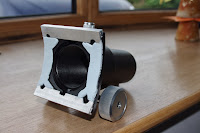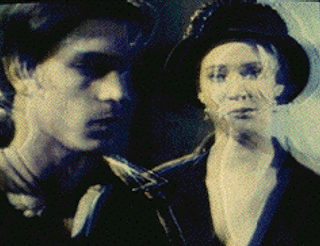My mathematical modelling has taken a detour away from soft-matter research and into the field of Evolutionary Game Theory. So, instead of studying material properties that emerge from vast collections of interacting molecules, I have been studying the strategies that emerge from vast collections of interacting agents (simulated beings that live in my computer).
It turns out that Evolutionary Game Theory (EGT) is as much fun as it sounds, even though the games in question won't win any 5-star reviews on gaming platforms, as they typically take a fraction of a second to play. In EGT, the complex competitive processes of life are modelled by simple agents playing a simple game. They reproduce and die according to the game’s outcome, and their offspring inherit imperfect copies of the parent’s strategy.
By applying techniques similar to those for analysing order and disorder of molecules, I have discovered some general features of Darwinian evolution, that can create highly altruistic behaviours in the presence of rare events such as gluts or disasters. The discovery was published last month in the paper "Pay-off scarcity causes evolution of risk-aversion and extreme altruism", R M L Evans, Scientific Reports (2018) 8:16074, at www.nature.com/articles/s41598-018-34384-w
There are a few well-established elementary games used by game-theorists. The agents in my simulations play one of those standard games, called the Ultimatum Game. Previously published studies of the game have involved humans, machines, and even capucin monkeys. So, whatever you are, you too can play. Here's how.
You'll need two friends: one to play the game with you, and the other in a sort of "Mother Nature" role, dictating the order of play and providing a bounty; say, £1. This £1 (or $1 or ¥1 - choose your favourite currency) represents some natural resource that the players may receive if they cooperate.
Mother Nature nominates one of the players to be the "proposer" and the other to be the "responder". The proposer offers some portion of the bounty (say, 10 pence) to the responder. If the responder accepts the offer, then the proposer keeps the remainder of the bounty (90 pence in this case). On the other hand, if the proposer rejects the offer, then NEITHER player receives anything. The offer is made once only; no back-and-forth haggling is allowed.
How much would you offer? How much would you accept? Since there is nothing to gain by rejecting an offer, you might expect the responder to accept any offer however low. And if the proposer is greedy, and is confident that the responder will accept any offer, then they will offer as little as possible (1 pence). Those particular strategies are known as the "Nash equilibrium" of the game, i.e. the set of strategies adopted by rational, self-interested players, playing against other rational, self-interested players. It is named after John Nash, the Nobel Laureate in Economics whose biography, "A beautiful mind" was made into an Oscar-winning film.
It turns out that Evolutionary Game Theory (EGT) is as much fun as it sounds, even though the games in question won't win any 5-star reviews on gaming platforms, as they typically take a fraction of a second to play. In EGT, the complex competitive processes of life are modelled by simple agents playing a simple game. They reproduce and die according to the game’s outcome, and their offspring inherit imperfect copies of the parent’s strategy.
By applying techniques similar to those for analysing order and disorder of molecules, I have discovered some general features of Darwinian evolution, that can create highly altruistic behaviours in the presence of rare events such as gluts or disasters. The discovery was published last month in the paper "Pay-off scarcity causes evolution of risk-aversion and extreme altruism", R M L Evans, Scientific Reports (2018) 8:16074, at www.nature.com/articles/s41598-018-34384-w
There are a few well-established elementary games used by game-theorists. The agents in my simulations play one of those standard games, called the Ultimatum Game. Previously published studies of the game have involved humans, machines, and even capucin monkeys. So, whatever you are, you too can play. Here's how.
You'll need two friends: one to play the game with you, and the other in a sort of "Mother Nature" role, dictating the order of play and providing a bounty; say, £1. This £1 (or $1 or ¥1 - choose your favourite currency) represents some natural resource that the players may receive if they cooperate.
Mother Nature nominates one of the players to be the "proposer" and the other to be the "responder". The proposer offers some portion of the bounty (say, 10 pence) to the responder. If the responder accepts the offer, then the proposer keeps the remainder of the bounty (90 pence in this case). On the other hand, if the proposer rejects the offer, then NEITHER player receives anything. The offer is made once only; no back-and-forth haggling is allowed.
How much would you offer? How much would you accept? Since there is nothing to gain by rejecting an offer, you might expect the responder to accept any offer however low. And if the proposer is greedy, and is confident that the responder will accept any offer, then they will offer as little as possible (1 pence). Those particular strategies are known as the "Nash equilibrium" of the game, i.e. the set of strategies adopted by rational, self-interested players, playing against other rational, self-interested players. It is named after John Nash, the Nobel Laureate in Economics whose biography, "A beautiful mind" was made into an Oscar-winning film.
Perhaps you feel uncomfortable with the idea of trying to fleece your fellow player by offering them the bare minimum, or with the idea of accepting a miserly offer. If so, you share that feeling with other humans and monkeys, who have been observed to offer typically between 10% and 50% of the bounty, in numerous studies of the ultimatum game. This is one trivial example of our in-built altruism (a tendency to help others even at cost to oneself) that is evident in countless more serious situations. For instance, many garden birds give alarm calls when they see a predator such as a cat. This is an altruistic behaviour because, while it may save other birds, it draws the cat's attention to the calling bird.
How do you suppose such altruistic behaviour evolved? The questions poses a fascinating conundrum. If a bird carries a gene that gives it a tendency to sound the alarm when it sees a cat, this bird is less likely to have offspring (owing to a fatal feline attack) than another bird without the gene. So, it seems that genes for altruism should quickly die out due to natural selection, out-competed by the descendants of individuals without the gene.
This conundrum has taxed the minds of scientists for several decades, during which a number of subtle processes have been discovered to produce altruism, within the framework of Darwinian evolution. "Kin selection" often plays a role. For example, whether by choice or by geographical necessity, a certain type of alarm-calling animal might tend to live in close proximity to its close relatives. Then many of the beneficiaries of its altruism also carry the altruistic gene. Thus the colony of altruists can out-compete neighbouring colonies whose members more often fall prey to unseen predators.
The newly published process for the evolution of altruism is different from kin selection, and from other processes previously known to promote altruistic behaviour. To explain it, let me tell you more about my simulations. The agents in my model are far simpler than birds or any other living organism, even bacteria. Each agent occupies a site on a square grid, so it has four neighbours to play with. The agents never move. Each agents has its own, unchanging strategy for playing the ultimatum game, should the need ever arise. That strategy consists of just two numbers: the offer that it will always make whenever it is chosen to play the role of proposer, and the threshold value for accepting offers whenever it acts as responder - it will always reject any offer below its personal threshold. Those two numbers comprise an agent's strategy.
In EGT, a strategy is like a genetic code, because it gets passed on to an agent's offspring whenever it reproduces. At the start of a simulation, an agent with a randomly assigned strategy (pair of numbers) is put onto each grid site. The grid is big, so there are typically around a quarter of a million agents. Then the simulation runs as follows. The computer picks an agent at random to propose its offer, and randomly picks one of its four neighbours to respond. They are each allocated some pretend money, or no money, according to the rules of the ultimatum game, and the computer updates each of their bank accounts. Then the process is repeated, with a new randomly chosen proposer and resonder, over and over again.
Sometimes, instead an agent being chosen to make a proposal, it is chosen to reproduce asexually. Its offspring inherits the parent's strategy, but with small random numbers added or subtracted from each. Since the grid is already full, where will this offspring live? One of the parent's neighbours must be replaced (to death; mwahahaha). The algorithm now chooses which of the four neighbours gets the chop, and the poorest neighbour is chosen with highest probability.
This whole process of births, deaths and games is repeated billions of times in each simulation. The process mimics Darwinian natural selection, because those who are most successful at the game (of life in the natural world, or the ultimatum game in this case), have the best chance of living long enough to reproduce, and their children inherit imperfect copies of their genome (or strategy).
"What strategies evolve?" I hear you ask. On the face of it, it seems obvious that the best strategies for getting rich should proliferate, so that the population will evolve towards the Nash equilibrium, giving away as little as possible and accepting every offer. Sure enough, the Nash equilibrium has previously been observed in a similar model with regular updates, where every agent makes its proposal once to each neighbour and then the richest ones reproduce. With randomness in the order of play (as in my simulations), it is already known that higher offers evolve: more generous that the Nash equilibrium, but below 50%. In those previous studies, the rate of births and deaths has always been similar to the rate of game play, so that most agents play the game once or twice in their lifetime.
One novelty of my work is that I set the rate of births and deaths to be extremely high, which, surprisingly, no-one has tried before. With reproduction occurring a hundred times as frequently as gaming, most agents in the simulation never get an opportunity to put their strategy into practice by actually playing a game. Typically, the family strategy is passed down from parent to child for a hundred generations between uses. Under these circumstances, I find that evolution switches from favouring greed to favouring generosity. In a population with such scarce opportunities for winning resources, the average offer rises to 75%, meaning that most proposers keep less for themselves than they give away. And their generosity is indiscriminate, because agents cannot recognise close kin or choose a recipient. While 75% is the average offer, many agents give away close to 100% of their budget. It is particularly surprising that families with such a strategy are not out-competed when they meet more selfish exploiters that accept their generosity but give little back when acting as proposer.
The underlying reasons for this strange and inspiring evolutionary phenomenon are subtle and connected to the statistics of random interactions that govern Brownian motion of molecules. A theorem, derived in my paper, shows that the phenomenon is not a quirk of the ultimatum game, but stems from a more general principle that, when pay-offs are very rare compared with life-expectancy, evolution no longer favours strategies that maximize an agent's average income, but instead selects strategies that minimize the risk of zero pay-off. You might think those are the same thing. But remember, a lot of random influences are at work - in the order of play, the arrangement of agents on the grid, the timing of births and deaths. So a given strategy does not reliably give a unique pay-off, but instead gives rise to a whole set of possible pay-offs with different probabilities. For instance, imagine that strategy A yields possible pay-offs with probabilities shown by the histogram in figure 1a, while strategy B leads to pay-offs with probabilities in figure 1b. On average, strategy B tends to give higher pay-offs. So evolution with favour organisms with that strategy if it is used reasonably often. But, if many generations pass between opportunities to play, then strategy A will evolve because it has a lower risk of missing out entirely on the rare resource, as shown by the lower bar at zero pay-off.
While several subtle effects are at play here, all discussed in the paper, one of the reasons for this extraordinary feature of evolution is quite straightforward. If pay-offs are very rare, then almost all individuals have exactly zero wealth. In that case, an individual with a strategy that wins even a tiny amount of wealth becomes the richest in its neighbourhood, and so out-competes its neighbours. There is thus no benefit in adopting a greedier strategy that wins more wealth.
This newly discovered evolution of risk-aversion and insensitivity to average pay-off has a levelling effect, removing the benefits of greed and promoting cooperation and altruism. So how is this relevant to the real world? Of course, we didn't play the ultimatum game in our distant evolutionary past. But, if the game represents rare life-changing events like disasters or gluts, requiring decisive action to avoid losing out, then a similar process might be responsible for the behavioural traits that evolved as a consequence. In the model, those traits, or strategies, are never actually used by most individuals for the purpose of that all-important but extraordinarily rare game. Nevertheless, those individuals carry a predisposition for altruism and pass it down the generations. Perhaps, then, the everyday altruism, that we observe in many real organisms, arises from a predisposition that evolved to survive much rarer and more significant events than we have seen in our lifetimes.


























.jpg)







